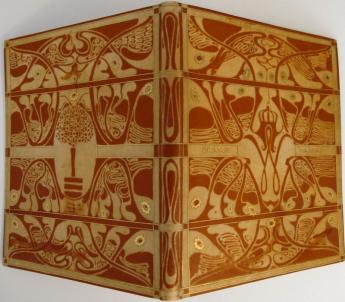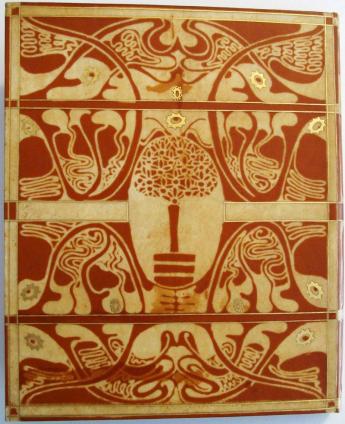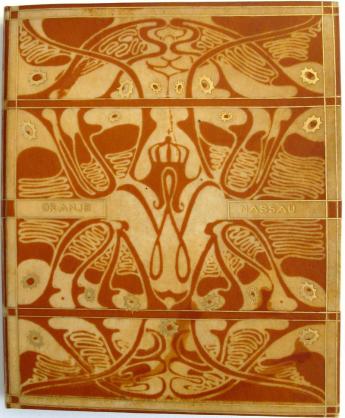Collecting - Serendipity and The Private Library

By Perkamentus
I visited a little antiquarian shop in Weesp (not far from Amsterdam) to do a little browsing. After half an hour I was done and ready to leave.
I was taking a last look at the shop's shelf of House of Orange books (books about the Dutch Royal House) when my eye was drawn to a book with an interesting but untitled spine. The book turned out to be a catalog of an exhibition of portraits and objects relating to the House of Orange-Nassau on the occasion of the inauguration of Her Majesty Queen Wilhelmina (1898).
The book contained some 120 pages, largely unopened. Enclosed separately was a small brochure with 21 pages of errata (including a corrected title page). The book lists over 1300 items without a single illustration:
Extremely unattractive! The binding, though, was breathtaking: Obviously parchment, gold tooled and printed in Art Nouveau style. But wait ... this gets better!
On the same shelf I found a little book by Marieke E. Spliethoff, Feestelijke geschenken voor de jonge Koningin 1898-1913 (Festive gifts for the young queen 1898-1913; Amsterdam/Den Haag, 1998). To my amazement, I found on page 44 of this book a large picture of a catalog that was bound in a style virtually identical to the one above - a catalog which had been given to the Royal Family when they visited this very exhibition over a century ago!
The binding (in both instances) was designed by Carel Adolph Lion Cachet (1864-1945), a famous Dutch Art Nouveau artist who was the first to apply the batik technique on parchment. I was shaking a bit as I read further:
“Lion Cachet had received many orders for luxury ties, wallets and boxes associated with the coronation of Queen Wilhelmina in 1898. His largest order was for the Catalogue of the exhibition of portraits and objects relating to the House of Orange-Nassau, from September 8 to October 31, held at the Rijksmuseum. Using more than 1300 items, the history of the dynasty from the sixteenth century to the time of the coronation of Queen Wilhelmina was shown. The catalog was published by the Amsterdam firm of Holkema and Warendorf. The order for Lion Cachet included 39 copies of the exhibition catalog bound in batik parchment -- one copy each for Queen Wilhelmina, Queen Emma and Princess Marie von Wied; six copies for the members of the organizing committee; and another thirty copies for foreign dignitaries.
Lion Cachet chose a motif of red cabbage leaves and ferns. In the centre of the upper cover he added a crowned W (Wilhelmina) and for the lower cover he designed a stylized orange tree. Upper and lower covers also have horizontal gold tooled bands to intensify the luxurious design of the book. While the Royal copies were executed in red and black on a white background, the other copies -- while carrying a similar decorative motif -- are executed primarily in orange and yellow. On 7 September 1898 Lion Cachet personally delivered some copies to the Rijksmuseum for Royal guests the next day. Some members of the committee had already received their copies. But it was not until Spring 1899 that all copies were finished and delivered.”
I suddenly realised that the book in I had in my hands was one of the very rare thirty-six copies that had been distributed to committee members and dignitaries!
Feverishly, I looked for the price. A pencilled inscription said 14 euros and a few cents (about U.S. $18.00). I took the catalog and Spliethoff's book slowly up to the front counter and paid. ‘Nice binding," the clerk mumbled. I didn’t say much. I paid and took off as fast as I could...!
Postscript: What I Learned from this Little Book Adventure
I have some knowledge about parchment bookbindings, but before my serendipitous discovery of this title had never heard of, or encountered an example of, batik utilized for a parchment binding.
The ridiculously low price I paid for this book is due to the shop owner's lack of knowledge and experience. I know for a fact that this shop uses Internet sites like Addall and Antiqbook to determine prices for the books it carries. The shop does a quick search to see if and where other copies have been sold, and for what prices. Anybody can do that, but what if you don’t find another copy? In this case, since the bookbinding is not signed, the shop probably figured it simply had a dull and boring book in a colorful board binding.
Morals of this story: (1) you don’t need a lot of money to build your private library (especially if you have more knowledge than the bookseller); (2) serendipity is the whole point of browsing brick-and-mortar bookshops....
***
Published as a guest editorial in The Private Library, presented here by permission of the author. Pictures: the author.


